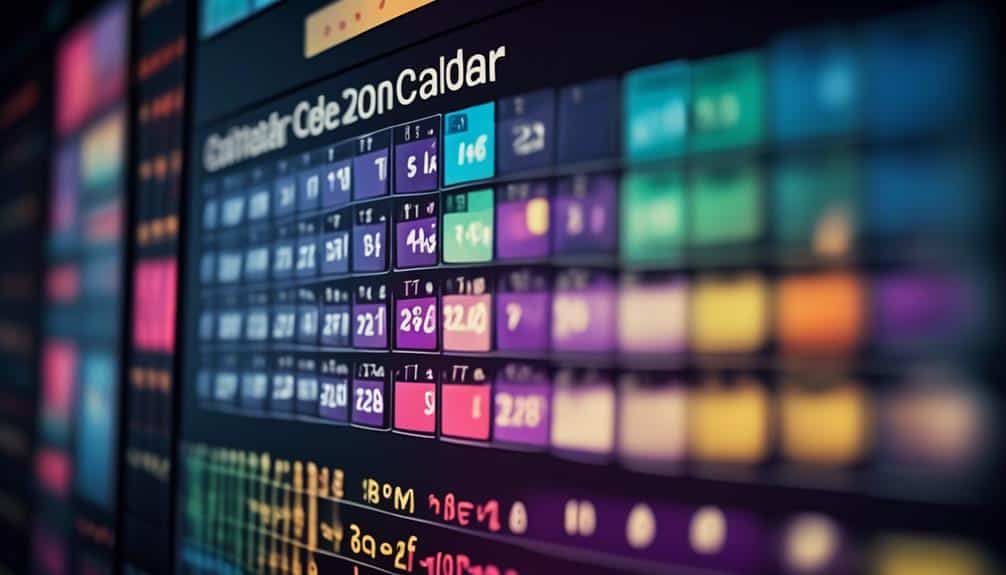Content Calendars Demystified: Tips for Efficient Planning and Execution
When it comes to content calendars, they can be more than just a schedule. By mastering the art of content calendar planning and execution, you can streamline your content creation process, ensure consistency across platforms, and maximize engagement with your audience.
But how exactly can you transform your content calendar from a mere timeline into a powerful tool that drives your content strategy forward? Let's explore some key tips and strategies that can help you efficiently plan and execute your content calendar to elevate your brand's online presence.
Key Takeaways
- Content calendars are essential for maintaining content consistency, planning, and scheduling across platforms.
- Tailoring content calendar formats to team and organizational needs can enhance content strategy effectiveness.
- Setting clear goals, regularly reviewing performance metrics, and incorporating innovative ideas are crucial for successful content calendar management.
- Segmenting content into specific categories and themes helps optimize content alignment, audience targeting, and strategic planning.
Importance of Content Calendars

Understanding the significance of content calendars can significantly enhance your content strategy's effectiveness and organization. Content consistency is crucial in maintaining audience engagement and brand identity. By using a content calendar, you can plan and schedule your posts, ensuring a steady flow of high-quality content across all your platforms. This consistency not only keeps your audience interested but also helps in establishing your brand as reliable and trustworthy.
Moreover, editorial organization is simplified through the use of content calendars. You can outline your content themes, plan relevant topics, and coordinate with your team effectively. This structured approach allows for better coordination between different departments, ensuring that everyone is aligned with the content strategy. Additionally, by having a clear overview of your content schedule, you can identify any gaps or overlaps in your content creation process, allowing for timely adjustments and improvements.
Types of Content Calendars
When it comes to content calendars, understanding different calendar formats and planning tools can greatly impact your content strategy.
By exploring various types of content calendars, you can tailor your approach to suit the needs of your team and organization.
Calendar formats and planning tools play a crucial role in organizing content creation and distribution efficiently.
Calendar Formats
Exploring different calendar formats can greatly enhance your content planning strategy and boost overall productivity.
When considering digital platforms, opt for tools like Google Calendar or Trello for seamless collaboration. These platforms allow you to organize content, set deadlines, and share updates effortlessly.
Visual layouts, such as Kanban boards or Gantt charts, offer a clear overview of your content schedule, making it easier to track progress and identify potential bottlenecks.
Experiment with color-coding, labels, or symbols to categorize content types or stages of development. By leveraging diverse calendar formats, you can tailor your approach to fit your team's needs and streamline the content creation process effectively.
Stay innovative and open to new methods to optimize your content calendar strategy.
Planning Tools
Enhance your content planning strategy by exploring various types of content calendars as essential planning tools.
When it comes to content planning, utilizing the right tools can make all the difference in maximizing efficiency and productivity. Consider the following types of content calendars as key assets for your planning process:
- Editorial Calendar: Ideal for mapping out content themes and publication dates.
- Social Media Calendar: Essential for scheduling posts and tracking engagement metrics.
- Collaborative Calendar: Perfect for team coordination, task management, and project tracking.
Setting Up Your Content Calendar

To effectively set up your content calendar, begin by outlining your goals and objectives for your content strategy. Time management is crucial in ensuring your content calendar is efficient and effective. Start by identifying key milestones, events, or product launches that you want to align your content with. Utilize organizational tips such as color-coding different types of content, assigning specific team members to tasks, and setting deadlines for each stage of content creation. This will help you stay on track and ensure all content is created and published in a timely manner.
Consider incorporating innovative ideas into your content calendar, such as themed months or interactive content series, to keep your audience engaged and excited. By strategically planning your content calendar with a mix of evergreen and timely content, you can maintain a consistent online presence and drive traffic to your platforms. Remember to regularly review and adjust your content calendar based on performance metrics and audience feedback to continuously improve your content strategy.
Establishing Content Categories
When organizing your content calendar, it's crucial to establish clear categories for your topics. Segmenting your content into specific themes can help you align your categories effectively.
Topic Segmentation Strategy
Optimizing your content calendar through effective topic segmentation is key to ensuring a strategic and organized approach to creating diverse content categories. When establishing content categories, consider the following:
- Audience Targeting:
- Tailor content to specific audience segments for increased engagement.
- Utilize data analytics to understand your audience's preferences and behaviors.
- Campaign Optimization:
- Align content categories with campaign objectives for cohesive messaging.
- Implement A/B testing to refine content strategies based on performance metrics.
- Content Variation:
- Diversify topics to cater to different audience interests and needs.
- Incorporate trending themes to stay relevant and capture attention.
Category Alignment Techniques
Establishing content categories with precision and foresight is crucial for effective category alignment techniques in your content calendar strategy.
Category mapping involves strategically defining the main themes or topics that your content will fall under. By categorizing your content, you can ensure a balanced distribution of different types of topics and maintain a cohesive structure in your calendar.
Topic clustering is another valuable technique where related subjects are grouped together, allowing you to spot trends, identify gaps, and create a more engaging content mix. This method helps in organizing your ideas and ensuring that your content is diverse and appealing to your audience.
Implementing these category alignment techniques will elevate your content strategy and drive innovation in your planning process.
Content Type Classification
To enhance the effectiveness of your content calendar strategy, strategically defining and categorizing the various types of content you plan to create is essential for ensuring a cohesive and balanced distribution. Proper content categorization can streamline your planning process and help you maintain a diverse yet focused content mix.
Consider the following subcategories to establish a robust content classification system:
- Format: Categorize content based on format (e.g., blog posts, videos, infographics).
- Purpose: Group content by its intended goal (e.g., educational, promotional, entertaining).
- Audience: Segment content according to target audience demographics and preferences.
Content Ideation and Scheduling
When planning your content calendar, remember to brainstorm diverse and engaging topics to keep your audience interested and informed. To ensure your editorial calendar is filled with fresh and captivating content, consider employing various brainstorming techniques. One effective method is mind mapping, where you jot down central themes and branch out into related ideas. Another approach is the 5 Whys technique, delving deeper into a topic by asking "why" multiple times to uncover insightful angles. Additionally, conducting audience surveys or social media polls can provide valuable input on what topics resonate with your viewers. Below is a table showcasing different content ideation strategies:
| Brainstorming Techniques | Description | Benefits |
|---|---|---|
| Mind Mapping | Visual representation of ideas | Stimulates creativity |
| 5 Whys Technique | Uncover root causes of topics | Encourages in-depth exploration |
| Audience Surveys | Direct feedback from viewers | Ensures content relevance |
Collaborating With Your Team

Maximize team productivity and creativity by fostering a collaborative environment that encourages open communication and idea-sharing. To enhance team collaboration and make the most out of brainstorm sessions, consider the following:
- Utilize Technology:
- Embrace digital tools like project management software or collaborative platforms to streamline communication and idea-sharing processes.
- Leverage features like real-time editing and commenting for efficient collaboration.
- Set up shared calendars to keep everyone informed about deadlines and content milestones.
- Encourage Diverse Perspectives:
- Embrace different viewpoints and encourage team members to share their unique ideas during brainstorm sessions.
- Rotate facilitation roles to ensure everyone has a chance to lead and contribute.
- Create a safe space where team members feel comfortable expressing unconventional ideas.
- Celebrate Team Achievements:
- Recognize and celebrate successful collaborations to boost morale and foster a sense of unity among team members.
- Acknowledge individual contributions within the team to promote a positive team dynamic.
- Host regular feedback sessions to reflect on past collaborations and identify areas for improvement.
Managing Deadlines and Updates
Embrace the momentum of your collaborative efforts by implementing effective strategies for managing deadlines and keeping everyone updated on progress. To ensure smooth workflow and timely content delivery, consider setting up regular meeting reminders to touch base with your team. These reminders can serve as checkpoints for progress tracking and provide opportunities to address any potential roadblocks promptly.
Utilize project management tools like Asana or Trello to create visual timelines that outline key milestones and deadlines. These platforms can help streamline communication by allowing team members to update tasks in real-time and track project progress collectively. Additionally, establish clear communication channels for sharing updates, whether through weekly status emails or instant messaging platforms like Slack.
Analyzing and Refining Your Strategy

To enhance the effectiveness of your content calendar, consider regularly evaluating and refining your strategic approach to ensure optimal results. Analyzing and refining your strategy is crucial in the ever-evolving landscape of content creation. Here are some key steps to help you elevate your content strategy:
- Performance Metrics:
- Track key performance indicators (KPIs) such as conversion rates, click-through rates, and social media engagement to gauge the success of your content.
- Use tools like Google Analytics or social media insights to gather data and analyze trends for informed decision-making.
- Audience Engagement:
- Foster two-way communication with your audience through polls, surveys, and interactive content to understand their preferences.
- Personalize your content to cater to different segments of your audience, increasing relevance and engagement.
- Continuous Optimization:
- Regularly review and adjust your content strategy based on performance metrics and audience feedback to stay aligned with your goals and adapt to market changes.
Frequently Asked Questions
How Can Content Calendars Be Used to Improve SEO and Drive Organic Traffic to a Website?
To boost your website's SEO and drive organic traffic, utilize content calendars. Strategically plan SEO strategies and keyword optimization. Consistent posting schedule enhances visibility, engages your audience, and increases website traffic, fostering organic growth and improving search engine rankings.
What Are Some Common Pitfalls to Avoid When Creating and Maintaining a Content Calendar?
To avoid common pitfalls in creating and maintaining a content calendar, focus on time management. Consistency challenges can arise, but with strategic planning and innovative solutions, you can stay organized and drive success in your content strategy.
How Can Content Calendars Be Integrated With Social Media Platforms for Effective Cross-Promotion?
To boost social media engagement, integrate content calendars with platforms for brand collaboration. Plan posts strategically to maximize exposure, drive traffic, and foster audience interaction. Creativity and consistency in cross-promotion will elevate your brand's online presence.
What Are Some Creative Ways to Repurpose and Recycle Content Within a Content Calendar?
Looking to breathe new life into your content? Explore innovative repurposing techniques and trends. Get creative with recycling old content. Maximize your reach and engagement by strategically leveraging your existing material.
How Can Content Calendars Help in Aligning Content With Specific Marketing Goals and Objectives?
To align strategies effectively, content calendars are your secret weapon. They help you track progress and ensure every piece of content serves your marketing goals. Stay organized, stay creative, and watch your campaigns flourish.
Conclusion
Now that you have a solid understanding of content calendars and how to efficiently plan and execute your content strategy, you're ready to take your marketing efforts to the next level.
By implementing the tips and strategies outlined in this article, you'll be able to stay organized, collaborate effectively with your team, and analyze and refine your content strategy for optimal results.
Keep up the great work and watch your content soar to new heights!








